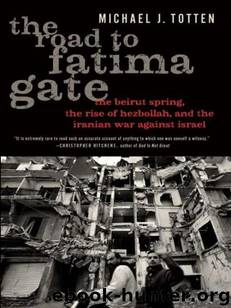The Road to Fatima Gate: The Beirut Spring, the Rise of Hezbollah, and the Iranian War Against Israel by Michael Totten

Author:Michael Totten [Totten, Michael]
Language: eng
Format: epub
Tags: General, History, Biography & Autobiography, Religion, Political Science, International Relations, Middle East, World, Terrorism, Middle Eastern, Religion; Politics & State, Editors; Journalists; Publishers
ISBN: 9781594035432
Publisher: Encounter Books
Published: 2011-11-15T11:24:11+00:00
CHAPTER TWELVE
the siege of ain ebel
The Western world should either defend us, or change its name.
—A LEBANESE CHRISTIAN LEADER DURING THE CIVIL WAR
A mid the south’s steep rolling hills, a mere handful of miles from the fence on the border with Israel, sat the besieged Christian community of Ain Ebel. It was often said that Lebanon is a victim of geography; few Lebanese were as unlucky as those who lived in Ain Ebel. For decades the people in this village were caught between the anvils of the Palestine Liberation Organization and Hezbollah on one side, and the hammer of the Israel Defense Forces on the other.
Noah and I had arranged to meet with Alan Barakat from the Ain Ebel Development Association. We met him outside a small grocery store owned by his uncle. He agreed to tell us about what happened to his community during the war in July, when Hezbollah seized civilian homes and used residents as human shields.
Ain Ebel was small, and we walked the streets on foot. I didn’t see nearly as much destruction as I saw in the Hezbollah strongholds of Maroun-al Ras and Bint Jbail. Downtown seemed intact. In that sense, South Lebanon’s Christians were lucky.
Downtown, so to speak, was hardly distinguishable from anywhere else in Ain Ebel. There wasn’t much to it aside from a grocery store. I saw only two restaurants—the one outside town where we had just stopped for lunch and a little pizza place around the corner and just up the hill.
The residents were implacably hostile to Hezbollah and always had been. This was not a place where the Party of God could dig in, build bunkers, and store weapons. From Israel’s point of view, Ain Ebel was, in military parlance, a “target poor” environment. That did not, however, stop Hezbollah from turning it into a battleground.
“There is a valley just below Ain Ebel,” Alan said. “I will take you there later. Until the army came after the war, Hezbollah closed it. It was a restricted military area. They built bunkers there and stored Katyusha rockets and launchers. When the war started, they moved the launchers out of the valley and into our village. When the Israelis shot back, they hit some of our houses.”
In Bint Jbail and Maroun al-Ras, whole city blocks were pulverized from the air. Some houses and buildings were merely damaged, but others were blown to their foundations. Nothing remained of whole swaths of these towns but fields of mostly cleared rubble. Hezbollah controlled Bint Jbail and Maroun al-Ras both before and during the war. Its fighters stockpiled rockets and other weapons in houses, turning them into targets.
Ain Ebel, however, was only used as a place to hide and as a place from which Hezbollah could launch rockets at the Israelis. Katyusha launchers weren’t placed inside houses. They were, for the most part, placed next to houses. Most of the property damage, then, was caused by shrapnel rather than direct hits.
Most homes in Ain Ebel were simple.
Download
This site does not store any files on its server. We only index and link to content provided by other sites. Please contact the content providers to delete copyright contents if any and email us, we'll remove relevant links or contents immediately.
| Africa | Americas |
| Arctic & Antarctica | Asia |
| Australia & Oceania | Europe |
| Middle East | Russia |
| United States | World |
| Ancient Civilizations | Military |
| Historical Study & Educational Resources |
Empire of the Sikhs by Patwant Singh(22922)
The Wind in My Hair by Masih Alinejad(5019)
Rise and Kill First by Ronen Bergman(4669)
The Templars by Dan Jones(4610)
The Rape of Nanking by Iris Chang(4116)
12 Strong by Doug Stanton(3466)
Blood and Sand by Alex Von Tunzelmann(3112)
The History of Jihad: From Muhammad to ISIS by Spencer Robert(2551)
Babylon's Ark by Lawrence Anthony(2507)
No Room for Small Dreams by Shimon Peres(2301)
Inside the Middle East by Avi Melamed(2288)
The Turkish Psychedelic Explosion by Daniel Spicer(2288)
Gideon's Spies: The Secret History of the Mossad by Gordon Thomas(2286)
Arabs by Eugene Rogan(2246)
The First Muslim The Story of Muhammad by Lesley Hazleton(2199)
Come, Tell Me How You Live by Mallowan Agatha Christie(2101)
Bus on Jaffa Road by Mike Kelly(2088)
Kabul 1841-42: Battle Story by Edmund Yorke(1969)
1453 by Roger Crowley(1929)
